Learning how to write the perfect personal vision statement is quite an adventure! You will learn all about yourself and what your preferences are, discovering where you should really focus your time, energy, and attention. This enlightened journey will surely change you forever!
To take on this challenge, you will need to understand the seven things you should include in a personal vision statement. The first is your values and beliefs, which shape who you have become. The second includes your many personality traits – what makes you who you are!
Gifts and talents come in third and are very important. Additionally, you’ll want to look at your strengths, weaknesses, opportunities, and challenges. Along with a few other things that you’ll have to discover by reading this article, you will embark on quite the adventure in doing this!
Learn all about the elements that make up the perfect personal vision statement to discover where you are headed and where you really want to be!
This post may contain affiliate links. Please read our Privacy Policy for more information.
What is a Personal Vision Statement?
A personal vision statement is a statement that makes up your personal vision or mission. It is similar to a business’s mission statement. When a business writes a mission statement, they are generally trying to tell you what they plan to do. With this “plan,” you can do almost anything!
By declaring your personal vision statement or writing it out on paper, you will be more likely to achieve your life’s goals and mission. Think about the blueprints for a building. Blueprints are created so that the builders know what they will be doing. It is a plan for the future.
In the same way, you are making a plan for your future when you write out your personal vision statement. It is typically not as simple as just writing out what you wish to do someday, but it can be a simplistic exercise, especially if you already have a solid plan in place for your life.
If you just write out, “I want to be a doctor,” you could likely achieve this goal if it was to be your life’s ambition, and you worked diligently at achieving it. However, your chances of success would increase if you spelled out the details of the who, what, when, and where.
As you wonder where you are headed in life, consider crafting a personal vision statement to voice where you are and where you want to be one day!
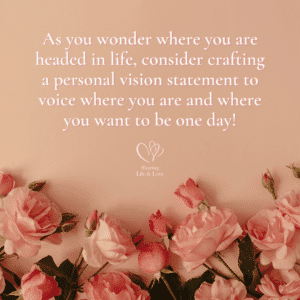
Your Spiritual Calling
Unfortunately, we often don’t know the details of where we are headed (for us planners). For example, if you are trying to determine what your spiritual calling is, God will likely reveal it in His time, not yours. We really cannot always force these things into existence.
But that’s what’s great about a personal vision statement is that you can craft it however you want, initially. Over time, you will want to shape it to match where you are in life. Additionally, you might have to change it altogether if your life’s circumstances change drastically.
Here are some helpful resources for discovering your spiritual calling:
- What Is My Spiritual Calling? (15 Clear Ways to Find Yours)
- 25 Exciting Ways to Discover Your Spiritual Purpose
- 6-Week Bible Study | How to Discover Your Spiritual Purpose +Leader’s Guide
- Discover Your Calling Week 1 – How to Identify God’s Will (Joseph)
- Discover Your Calling Week 2 | Why You Should Follow God’s Will (Ruth)
- Discover Your Calling Week 3 – How to Wait on God’s Timing (Noah)
- Discover Your Calling Week 4 | How to Trust God’s Will (Rahab)
- Discover Your Calling Week 5 | How to Discern God’s Will – 1 Samuel
- Discover Your Calling Week 6 – How to Return to God’s Will (David)
Your spiritual calling is what God needs you to do on earth. – Shana Scott

What Makes Up a Personal Vision Statement? (7 Things)
Your personal vision statement can consist of whatever you need it to. However, a few things might be helpful to include. Not all elements will apply to everyone. A student who has never faced a real challenge will likely not want to include challenges as part of their vision statement.
You can include in your vision statement your values, beliefs, personality traits, gifts, talents, life experiences, current responsibilities, opportunities, challenges, strengths, and weaknesses. Add some or all of these elements to your vision statement to further enhance it and make it fuller.
Values and Beliefs
Values and beliefs are components in you that shape how you make decisions and, therefore, alter or form what you do on a daily basis. Many are determined by the way you were raised.
If you were brought up to believe that black cats were unlucky, you will likely hold this belief. If your parents valued honesty, you will most certainly be affected by this, as well.
Values and beliefs can shape you positively or negatively. It all depends on how you allow them to determine who you are. It’s important that you identify what your values and beliefs are to accurately craft your personal vision statement.
Grab a FREE list of 50 popular values by James Clear. Use this list to help you narrow down what yours are.
Your values and beliefs shape your decisions and make up who you are today.
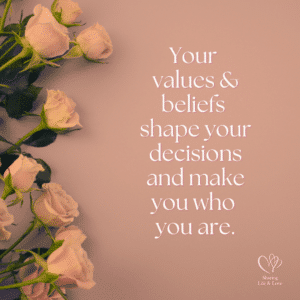
Personality Traits
Personality traits are your characteristics, the make-up that makes you uniquely you. These characteristics create patterns inside of you that shape how you act, what you say, and everything that you do. If you enjoy being in control, you might be a dominant person.
When a person agrees with everything you say, regardless if they actually agree or disagree, you might call that person “agreeable.” However, “agreeable” can denote a person who makes peace with others by finding a way to find an agreeable outcome – a neutral ground.
Someone who is ambitious might do whatever it takes to get to the top of the corporate ladder. However, someone who went to many years of college and became a doctor or lawyer at the end of their tenure of education might also be called ambitious.
As you can see, some personality traits have negative connotations associated with them, but, viewing them with a more open mind, can also show them to be quite positive. It is important to consider the context of the word when using it.
ProWritingAid has a very long FREE list of personality traits for writers to use when crafting their character biographies. This list will prove very helpful if you wish to find some personality traits. Additionally, you can take many online free personality tests to aid in your quest.
Understanding your personality traits can be a great tool in your personal vision quest.
Gifts and Talents
Gifts and talents are given to you. If you are creative and skilled at playing musical instruments, you are musically talented. You can and should use your gifts and talents when writing your vision statement because they are part of who you are and what you can do.
Gifts Test provides a FREE Spiritual Gifts Test that you can take. Additionally, they have a FREE list of spiritual gifts along with each definition and correlating Scripture. The spiritual gifts listed in the Bible are found in 1 Corinthians 12 and Romans 12.
Now to each one, the manifestation of the Spirit is given for the common good. – 1 Corinthians 12:7
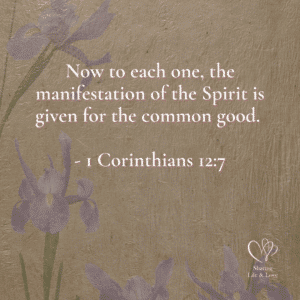
Life Experiences and Current Responsibilities
As much as your beliefs, values, gifts, and talents can shape you, nothing can prepare you for life experiences that are in and out of your control. Along with these experiences come responsibilities – things you can’t overlook or easily bypass, but rather, embrace lovingly.
An example here might be the life experience of being married and having children. If you are currently a stay-at-home mother, raising young children, you likely have your hands full, especially if you are actively involved in their lives or even educating them from home.
Juggling things like homeschool education and dinner on the table each night will need to be taken into consideration when writing your personal vision statement. You do not want to overcommit yourself or reach for goals that are unattainable due to your responsibilities.
Life experiences and current responsibilities go hand in hand as things you cannot overlook when writing a personal vision statement but rather are things you lovingly embrace.
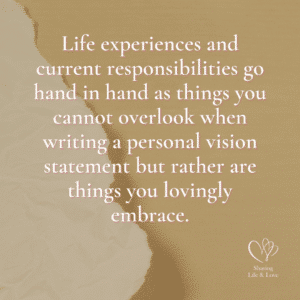
Opportunities and Challenges
Opportunities are circumstances that come your way that are usually favorable in nature. For example, maybe you have been offered a promotion or are getting married next month. If there is something positive occurring in your life, it is an opportunity for growth.
Challenges might not be negative in nature but can be things that stand in the way of your goals or the initial path that you were going to take. A challenge might be getting a broken leg before a big event or having a family member drop by unexpectedly before a hot date.
Both opportunities and challenges can prove to help you grow if you allow them to. If your family member stops by and interrupts your schedule, you do not have to be polite and allow them to spoil your plans. Instead, be honest, and grow from the challenge of having to speak up.
Including all current opportunities and challenges can help you as you write your personal vision statement. If you do not include these circumstances or possible events in your personal vision statement, it will likely be more difficult to make it come to pass.
A successful vision statement will encompass the truth of all current circumstances – both good and bad!

Strengths and Weaknesses
Understanding your strengths and weaknesses can be enlightening. You can prosper in the areas where you are strong and grow in the areas where you are weak. As you write your personal vision statement, you’ll want to take it all into consideration.
Positive Psychology has a FREE list of 90+ strengths for your purview. Be sure not to overstate your strengths, though. It can be easy to see yourself shine in many areas, but real growth comes when you see the positives and negatives of who you are.
To determine where your weaknesses lie, ask your spouse or best friend. Alternatively, you can use the opposite descriptors of the words provided in the above list. However, the list does discuss weaknesses and lists a few, such as inflexibility and predictability.
The most proactive thing you can do once you’ve identified your weaknesses is to review them and their definitions thoroughly to ensure you understand what is meant by them. Then, make a list of ways you can improve these problem areas.
For example, if you are too predictable, try changing up your schedule every other day or introducing something unpredictable, like a new puppy (of course with the approval of your housemates, spouse, or roommates)! Additionally, research ways to be “less predictable.”
Changing your weaknesses won’t happen overnight, but once it does happen, you will have an abundance of dividends.
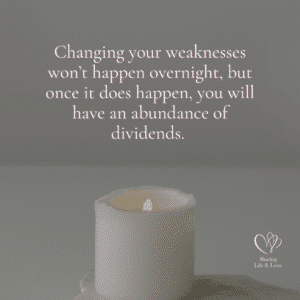
Goals and Objectives
The final component of your personal vision statement is determining your goals and objectives. If you write a stellar vision statement but do not incorporate the things you want to achieve in it, it will not be worth much to you because you’ll lack the motivation you need.
Determine what you want to accomplish in life. It could be as big as a visit to the moon or as small as speaking to a neighbor that you have never met. Maybe you’d like to visit your grandkids who live in another state or save $1,000 for a specific purchase.
Goals can be spiritual, financial, social, educational, personal, business, fun, and so much more. In fact, there are entire websites dedicated to goal achievement. As you do a bit of a search in each area of your life to narrow down your goals, do not get overwhelmed!
Here are some good guidelines when creating goals:
- Create 1-3 goals per area to keep it simple.
- Make sure your goals are SMART (specific, measurable, attainable, realistic, and time-bound).
- When deciding on a goal, think of what habits you do and don’t want to start or stop.
- Create goals that are approximately 3 to 6 months in nature, if applicable.
- Don’t aim to achieve more than 5-10 goals at a time.
- Limit your research time when reading about goals, staying clear of rabbit holes.
Finally, here are some useful resources to help you as you research various goals:
- Spiritual Goals | How to Get Started (with Free Worksheet)
- 75+ Spiritual Goals Examples and Free Goal Worksheet
- How to Achieve Your Goals Bible Study (5 Days)
- Goal Setting Templates – FREE Helpful Worksheets
I can do all things through Him who gives me strength. – Philippians 4:13
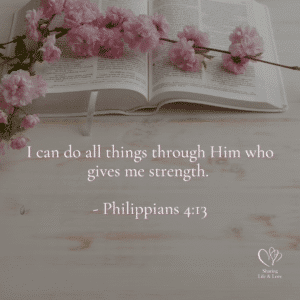
How to Write the Perfect Personal Vision Statement
The main part of writing the perfect personal vision statement is putting all of the pieces together. Not all of the pieces might mesh well, but if applicable, try to put them into your vision statement. If one aspect or piece listed above does not apply to you, do not worry about it.
Keep in mind a couple of things. First, what do you really want to do with your life? Second, why do you think you were put on this planet? Finally, where do you feel the nudges in life? That is God giving you little hints at what you are good at. He gave you those desires and talents!
Putting It All Together
As you look at your values, decide what kind of person you want to be. Do you want to be like your family and friends or branch out and become someone totally different? Incorporate the ideas of what your beliefs and values are into your personal vision statement.
As you write out the goals or statements that reflect your values and beliefs, think about how much education you need or want, how enthusiastic you wish to be about your vision, what accomplishments are needed to fulfill your vision, and how patient and brave you must be.
In the same way, look at your personality. Are you more of an introvert or extrovert? Which do you want to be? If a change is needed, incorporate it in your written personal vision statement. Aim to be positive and take the risks that you need to in order to accomplish your goals.
In all of the discussed elements, do your research and think about what you love to do. What are you good at? In which areas of life do you gravitate? That is likely the area you want to focus on in your personal vision statement. Don’t aim to please others; just God and self.
Remember to have fun as you work on your personal vision statement. Don’t allow the task of putting one together to weigh heavily on you, but rather, enjoy every word so that you can repeat it on a regular basis. This will give you something to aim for and be passionate about.
Since your true vision is given by God, who or what can stop you from achieving it?
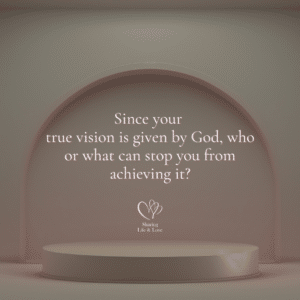
Frequently Asked Questions
Consider the following frequently asked questions about personal vision statements as you work to create and craft your own. You can do this!
What is an example of a personal vision?
I wish to be an astronaut in the next ten years or I want to have children and be married in the next decade are examples of visions. They might both seem unattainable to some, but to others, they are too simple. Everyone is different when it comes to personal vision.
What are spiritual habits?
Spiritual habits are things that you do in order to accomplish your spiritual goals. For example, you might spend 30 minutes a day praying or studying your Bible if you wish to have a closer relationship with God. Fasting could also be a beneficial habit or discipline to try.
How do you fulfill your personal vision statement?
In order to fulfill your personal vision statement, you will need to set goals that relate to what you wish to accomplish. It might be helpful to make a list of habits you need to start or stop in order to achieve the goals you need to do so that you can fulfill your vision.
How long should a vision statement be?
A vision statement can be as long as you wish it or need it to be. However, if it is more than a page in length, you might find it difficult to review on a daily basis. Alternatively, if it is too short, you might lose motivation as you lack clarity in the details of your vision.
Why do some personal vision statements fail?
Some personal vision statements fail because the individual was never properly motivated to live it to its fullest. For example, if the vision was to be a doctor, but the person has no desire to go to school for a long period of time, they will be unable to live out that vision.
Conclusion
Now that you know how to write the perfect personal vision statement, how will you craft yours? What attributes or personality traits do you want to work on? Where will you focus your attention? How will you allow your personal vision statement to change you this year?
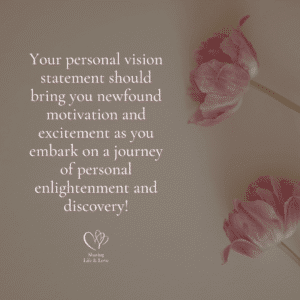
Your personal vision statement should bring you newfound motivation and excitement as you embark on a journey of personal enlightenment and discovery!



